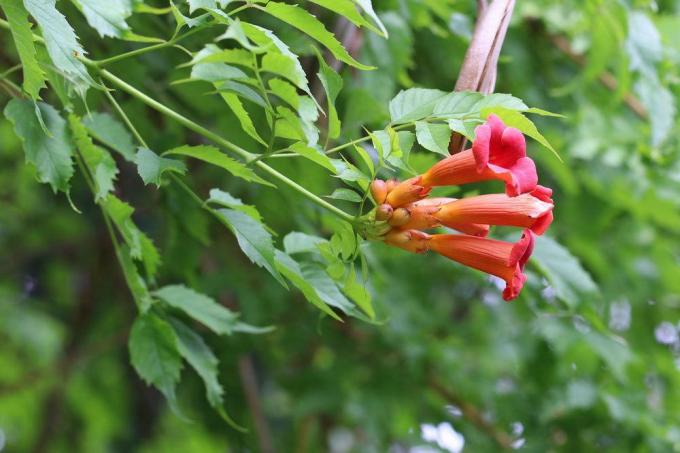
table of contents
- Climbing plants for the balcony
- Location
- Planter and substrate
- Perennial hardy climbing plants
- From B -C
- From G - T
- Annuals continuously blooming
- Perennial, frost-sensitive climbing plants
- From D - L
- From M - S
Flowering climbing plants are one of the true natural beauties. They are suitable as a facade greening or as a visually successful privacy screen for the balcony and roof terrace. In this way, they not only create places of retreat and privacy, but also act as eye-catchers with special splashes of color. Not all flowering climbing plants are also suitable for cultivation in the tub on the balcony, because there are a few important factors to consider.
Climbing plants for the balcony
Even before you go to the garden center or a nursery, you should consider which plants are particularly comfortable on your balcony with the local conditions. Perhaps the climbing plant should not only be a visual highlight, but also take on other functions on the balcony. When choosing, the following questions are important:
- How much sun does the balcony get?
- How and where can a climbing aid be attached?
- Which climbing aid does the respective plant need?
- Would you like to hide unsightly walls or downpipes?
- Should the climbing plant provide shade?
- Do you prefer annual or perennial plants?
- Should the climbing plant also wear foliage in winter?
- Do you prefer certain colors?
Location
The most important factor for healthy growth is the right location. In this respect, climbing plants are no different from any other plant in the garden. In order for a climbing plant to bloom abundantly, however, a few hours of sunshine a day are usually necessary. The selection for flowering specimens on a pure north balcony are therefore few and far between. On the other hand, there aren't too many plants that can blazing sun tolerated in the lunchtime.
- South-facing balcony: heat-tolerant plants that can cope with drought
- West and east balconies: optimal conditions for almost all climbing plants
- North orientation: flowering, shade-tolerant forest climbing plants
Note: Sun-hungry climbing plants often grow vigorously in shady locations, but then bloom less productively.
Planter and substrate
When choosing the container for the climbing plant, remember that it should be sufficiently stable and with as high a wall as possible. The roots of most climbing plants grow deeply and therefore require a lot of space in this direction. If you want to keep perennial climbing plants on the balcony, the following applies: the bigger the pot, the better. We recommend planters with a soil volume of 20 liters or more.
- high, sturdy pot
- preferably vessels made of light-colored material (wood or clay)
- high quality pail substrate
- pay attention to the correct composition for the plant
Perennial hardy climbing plants
Once planted, perennial climbing plants ensure an abundance of flowers on the balcony every year. Most of them do not need a lot of care, apart from regular water and fertilizer applications, a cut and good winter protection for the root ball.
From B -C
Wisteria (Wistera sinensis)
The wisteria creates a wonderfully Asian ambience. This climbing plant is not only characterized by an enormous abundance of flowers, but also by its enormous vigor. Wisteria can reach heights of up to 20 meters and grow very expansively. For this reason, they are only suitable for very large balconies and roof terraces. If the wisteria is not given a stable climbing aid, it can cause damage to the facade. Cultivation is worthwhile despite the high level of care required because of the regular, vigorous pruning also on the balcony, because hardly any other climbing plant can match the abundance of flowers in wisteria keep up.
- Location: sunny and protected (fewer flowers in partial shade)
- often does not bloom for years
- not so vigorous in the bucket
- strong, robust trellis necessary (pergola or similar)
- never sit on the house wall or downpipes

Clematis
Do you love clematis, but don't have your own garden, but a balcony? Then the many new varieties are just right for you. Because especially the low-growing clematis varieties can also be cultivated in a tub without any problems. Among the Integrifolia hybrids there are some that also do well in pots. The same goes for the large-flowered hybrids. If you can put the pot in a sheltered place in winter, it is also possible to cultivate frost-sensitive clematis varieties.
- only use low-growing varieties for balconies
- Climbing aid: simple climbing aid (for creepers)
- Location: shady (new varieties also for sunny places)
- Buckets with roots always in the shade
- Hybrids 'Durandii' and 'Alba'
- Texas clematis (Clematis texensis)
- Classics like 'Princess Diana' or 'Etoile Rose'
- large-flowered varieties: 'Prince Charles' and 'Königskind'
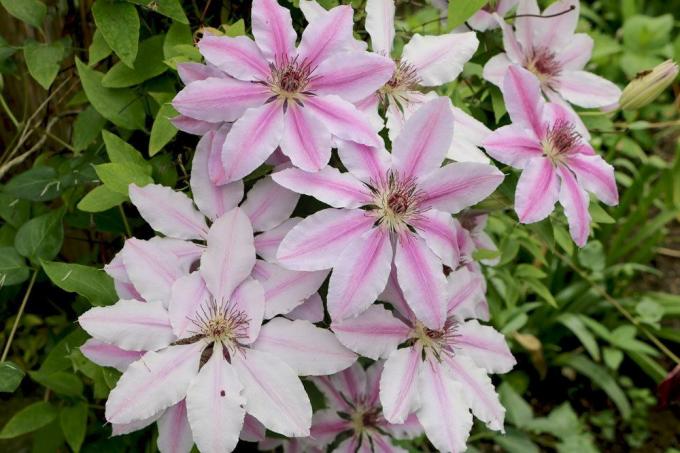
tip: A clematis does well in the shade, so it is a flowering alternative to ivy on north-facing balconies.
From G - T
Honeysuckle (Lonicera)
Honeysuckle, also called Jelängerjelieber, goat snake or honeysuckle, are climbing plants that are valued above all for their beautiful flowers that exude a delicate scent. In terms of their location, however, the honeysuckle is somewhat more demanding than other climbing plants. However, if you choose the right species for the location, the climbing plant from Asia will quickly become a permanent eye-catcher on the balcony.
- Location: depending on the variety, sunny to light shade
- Shading of the trunk foot on south-facing balconies is advantageous
- partly evergreen
- Trellis: Shapes with transverse elements to prevent slipping
- Japanese honeysuckle (Lonicera japonica): fragrant flowers from June to September
- Red honeysuckle (Lonicera x brownii): red flowers from June to October, slow-growing
- Fire honeysuckle (Lonicera x heckrottii): lush flowers from May to September
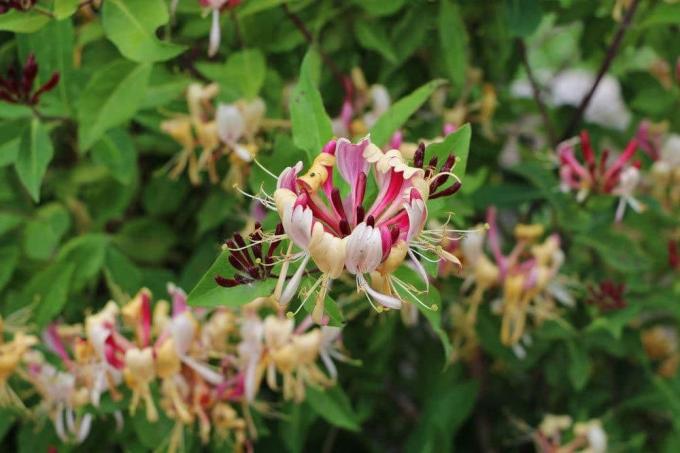
Trumpet Flower (Campsis)
Because of their exotic flowers, trumpet flowers (climbing trumpets) are popular for greening facades and balconies. With them you can not only conceal unsightly downpipes, but also quickly a productively blooming one Privacy screen create. It is true that the trumpet flowers are among the self-climbers that can reach heights of up to 12 meters with their adhesive roots. Nevertheless, a climbing aid is strongly recommended to absorb the enormous weight of the overhanging shoots. Good care thanks to the trumpet bindweed with a lush bloom between June and September.
- Location: sunny to partially shaded
- warm and sheltered from the wind
- Shading at the foot facing south
- Climbing aid: pergola, other stable structures
- Campsis radicans.
- 'Flamenco': dense, dark red flowers, good frost resistance
- 'Stromboli': vigorous, lush abundance of flowers in red tones, good frost resistance
- Campsis tagliabuana 'Indian Summer': very dense population with conspicuous orange flowers, well frost hardy
Annuals continuously blooming
In addition to the abundant flowering perennial climbing plants, there are also a large number of annual species that present their blossoms on the balcony throughout the summer. The annual growth is not necessarily a disadvantage. Because in this case there is no need for winter protection or costly cutting work. Annual climbing plants on the balcony usually require a significantly smaller planter and do not have to be repotted. This is especially ideal for balconies with little space.
Sweet pea (Lathyrus odoratus)
The climbing plant, also known as the sweet pea or sweet pea, is one of the butterflies and originally comes from Italy. Together with the perennial vetch, it is one of the most popular climbing plants that grow over the Summer with its white, pink, red, lavender or blue flowers, window boxes and trellises adorn. The sweet pea climbs with its leaf tendrils and is between 140 and 200 centimeters high.
- Location: sunny to partially shaded, warm, sheltered from the wind
- does not tolerate midday sun and drafts
- preferably free standing (instead of on walls or facades)
- Trellis: simple to medium construction (maximum diameter 0.5 cm)
- Spencer varieties: although poorly scented, but richly blooming varieties
- 'Cupani': strongly scented, two-colored flowering variety in purple and blue
- 'Dolly Varden': white and pink flowers

Nasturtium (Tropaeolum)
The nasturtium is one of the particularly decorative and uncomplicated climbing plants. It hardly makes any demands on its location, but develops a greater abundance of flowers in a sunny, sheltered location. The bright, permanent bloomer impresses with a sun-yellow, orange or red flower pile, depending on the variety. The flowers are even edible.
- Height: up to 3 m
- Location: full sun (tolerates heat)
- Climbing aid: close-meshed (rope systems, wire netting)
- also tolerates drought and nutrient-poor soils
Perennial, frost-sensitive climbing plants
Some climbing plants are naturally perennial, but are only cultivated as an annual in our latitudes. This is mostly due to the fact that overwintering is more costly and difficult than sowing again in spring. However, if you can offer the plant appropriate winter quarters, you will enjoy the climbing plant for many years.
From D - L
Triplet flower (Bougainvillae glabra)
The bougainvillae is one of the most magnificent flowering shrubs that the tropical regions have to offer. The triplet flower can also be easily grown in a tub, because it is not very demanding in terms of its care conditions. However, the colorful wonder flower plant is sensitive to frost and has to overwinter in the winter garden or house.
- Height: up to 5 m
- Location: sunny, warm and protected
- Trellis: robust trellis
- heavily overhanging
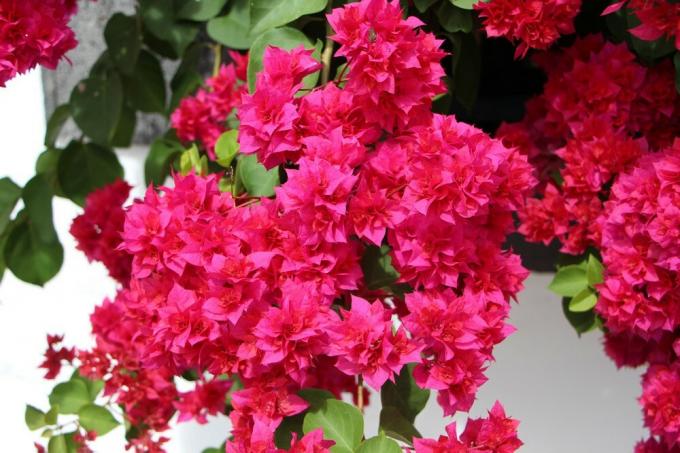
Losstrauch (Clerodendrum thomsoniae)
The climbing loose tree with its butterfly-like flowers is a real eye-catcher on the balcony. Red in combination with cream tones are the colors from which the climbing plant composes its flowers of glory.
- Location: sunny balcony or roof terrace
- protected from the midday sun
- only partially frost hardy
- Height: up to three meters on trellis (trellis)
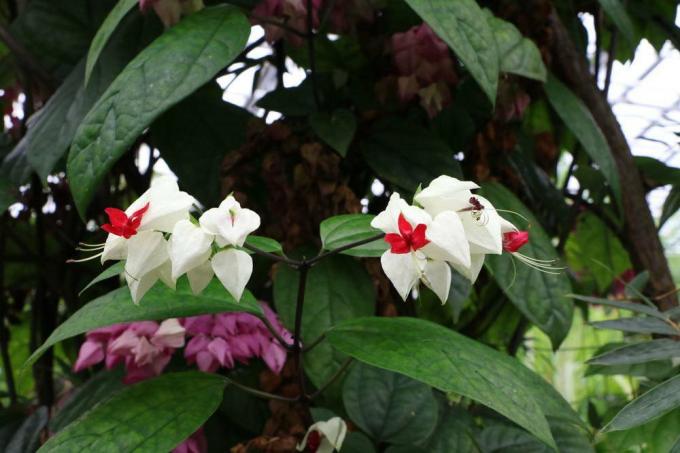
From M - S
Mandevilla (Dipladenia)
While the Dipladenia was only suitable for indoor and winter garden cultivation until a few years ago, it has been experiencing a renaissance in the outdoor area since around 2000. The new varieties are not only easy to care for, they are also heat-tolerant. Therefore, in contrast to clematis and roses, Mandevillas are also suitable for hot south-facing balconies. The funnel-shaped white, red, yellow or pink flowers then form in large numbers between the end of April and the first frosts.
- Location: sunny
- tolerates heat
- Height: up to 5 m
- Climbing aid: vertical struts (twisting growth)

Black-eyed Susan (Thunbegia alata)
The black-eyed Susanne is one of the uncomplicated climbing plants for the balcony. It originally comes from the tropical regions of Africa and heralds the new gardening year at the end of winter. In their homeland, the blooming beauty grows for several years. In our country, on the other hand, it is usually only cultivated once a year. Since the black-eyed Susanne needs around four months before it unfolds its blossoming splendor, it makes sense to grow it in the house from seeds as early as January.
- Height: between 2 and 4 m (depending on the climate)
- pastel-colored varieties: only up to about 1.8 m
- Location: protected south-facing position
- Trellis: almost all variants possible


